Abstract
Human polymorphonuclear granulocytes (PMN) generate the inflammatory mediator leukotriene B4 (LTB4) as a response to cell activation. In addition, PMN inactivate LTB4 by omega-oxidation resulting in the formation of 20-OH- and 20-COOH-LTB4. The transport of exogenous LTB4 to the metabolizing enzymes is mediated via high- and low-affinity receptor subsets. Uptake of [3H]LTB4 by the cells was carried out in a time-dependent fashion, reaching maximal values after 5 min of incubation. No additional uptake of [3H]LTB4 then occurred. Prestimulation of PMN with phorbol myristate acetate or sodium fluoride resulted in the loss of high- and low-affinity receptors. Deactivating concentrations of LTB4 specifically reduced the high-affinity receptor subset. Prestimulation of PMN with cytochalasin B or with the membrane fluidizer butanol shifted the low-affinity receptors to the high-affinity state. The polyene antibiotic amphotericin B shifted high-affinity receptors to the low-affinity subset. The changes in the receptor expression pattern correlated with the respective conversion rate of exogenously added LTB4. Our results suggest that the distribution of high- and low-affinity receptors is regulated by GTP-binding proteins, the activation of protein kinase C and the organization of the membrane bilayer. In this way, human neutrophils control the respective level of the lipid mediator LTB4.
Full text
PDF
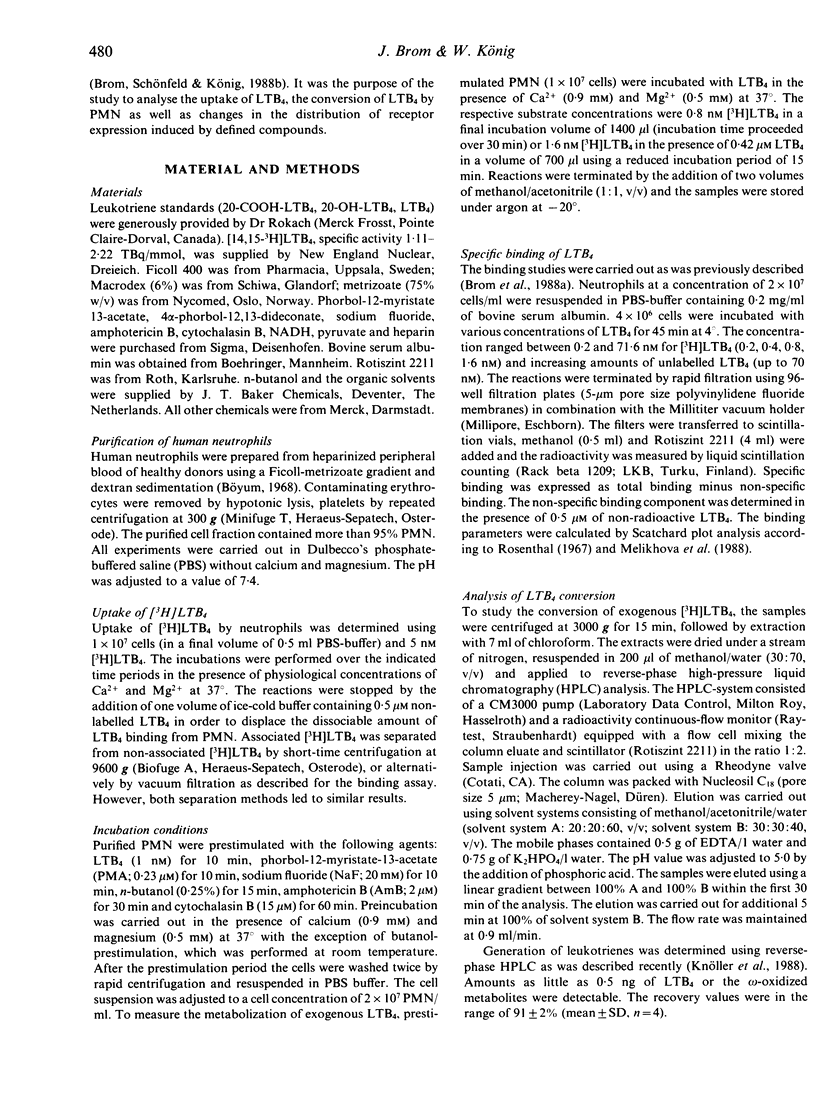
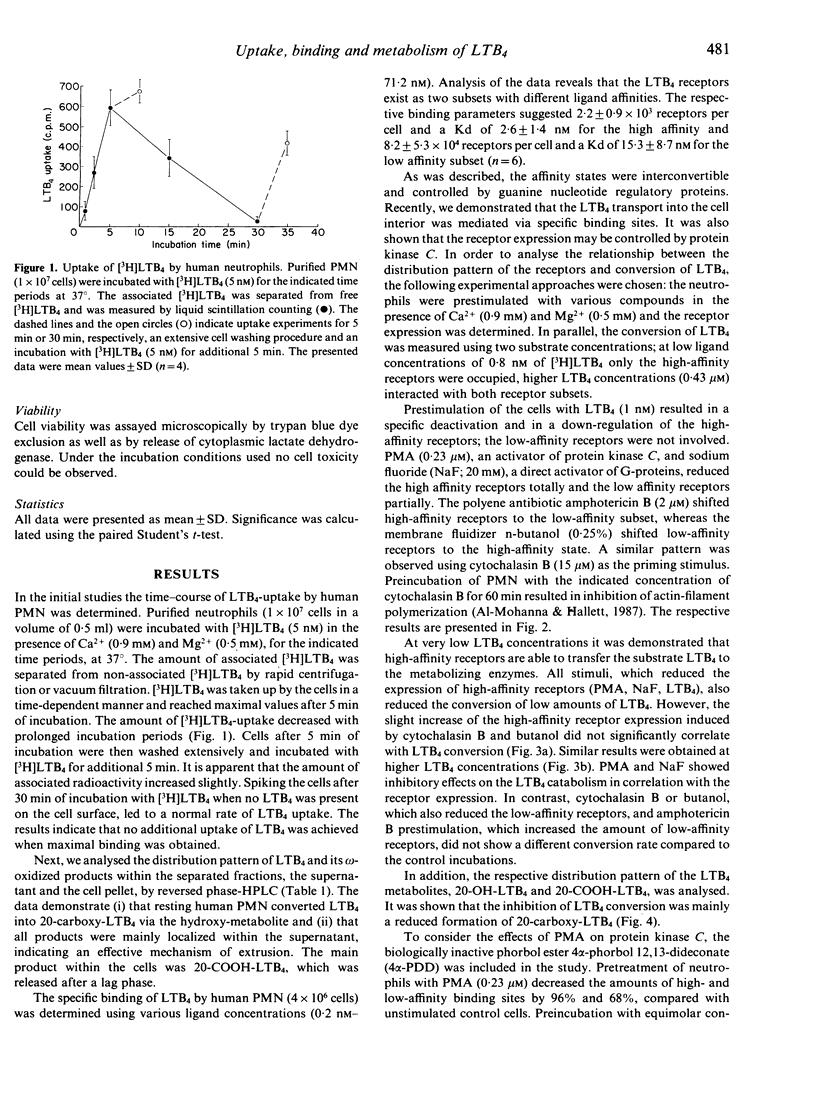
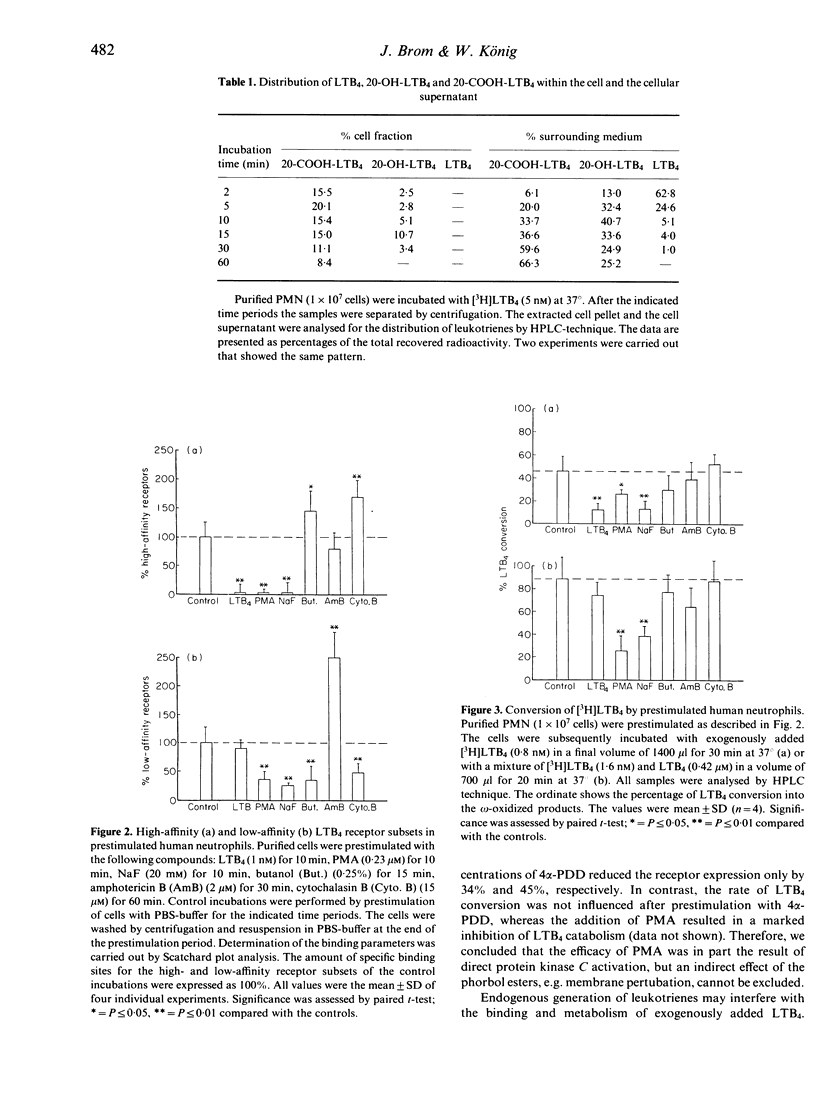
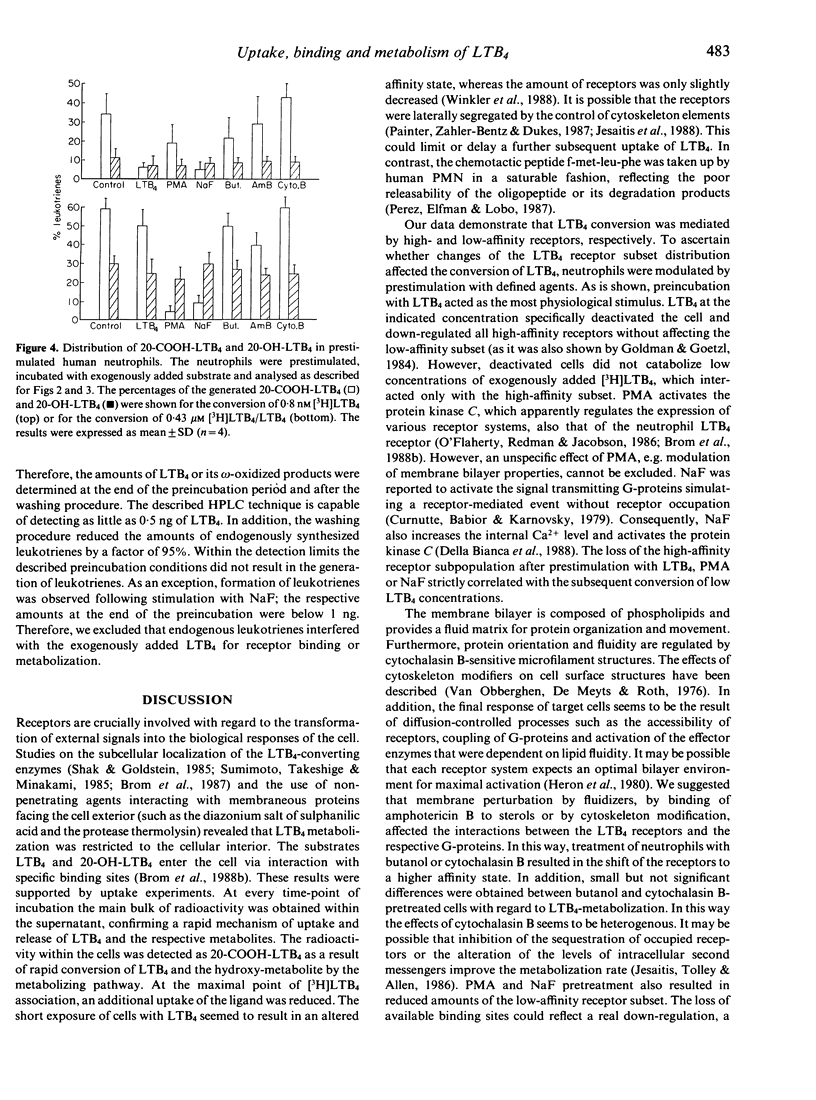
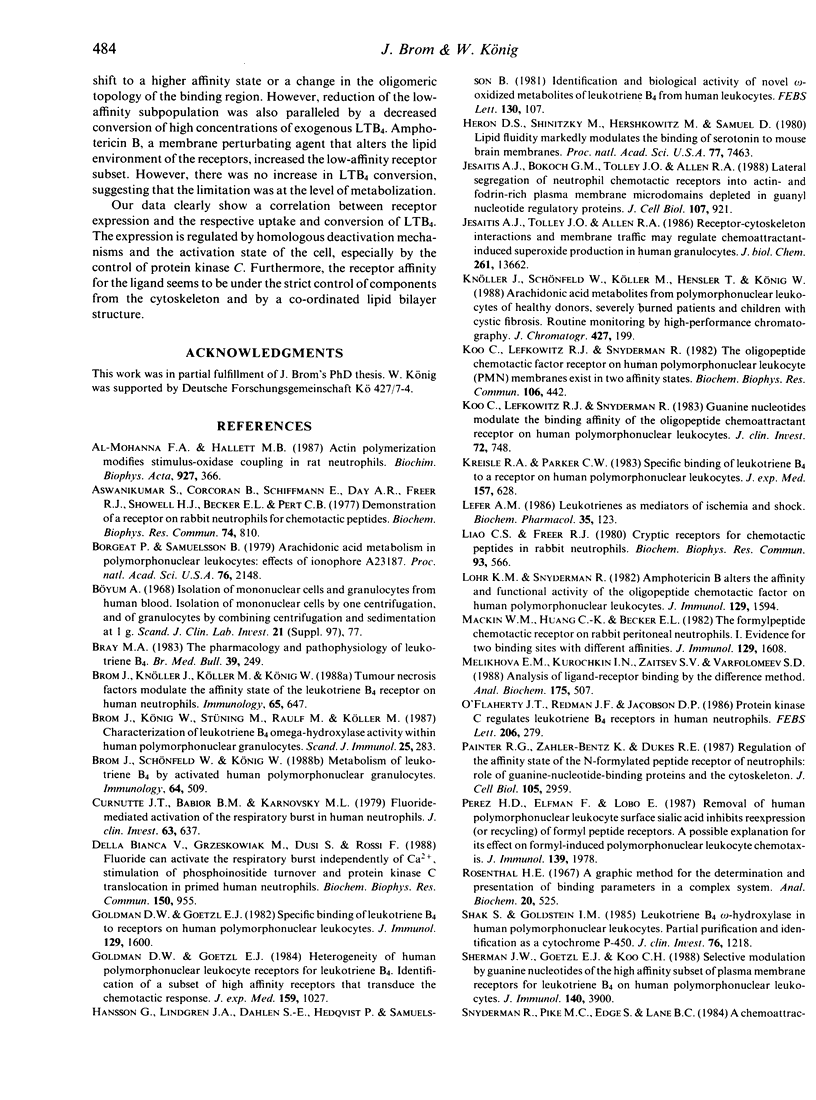
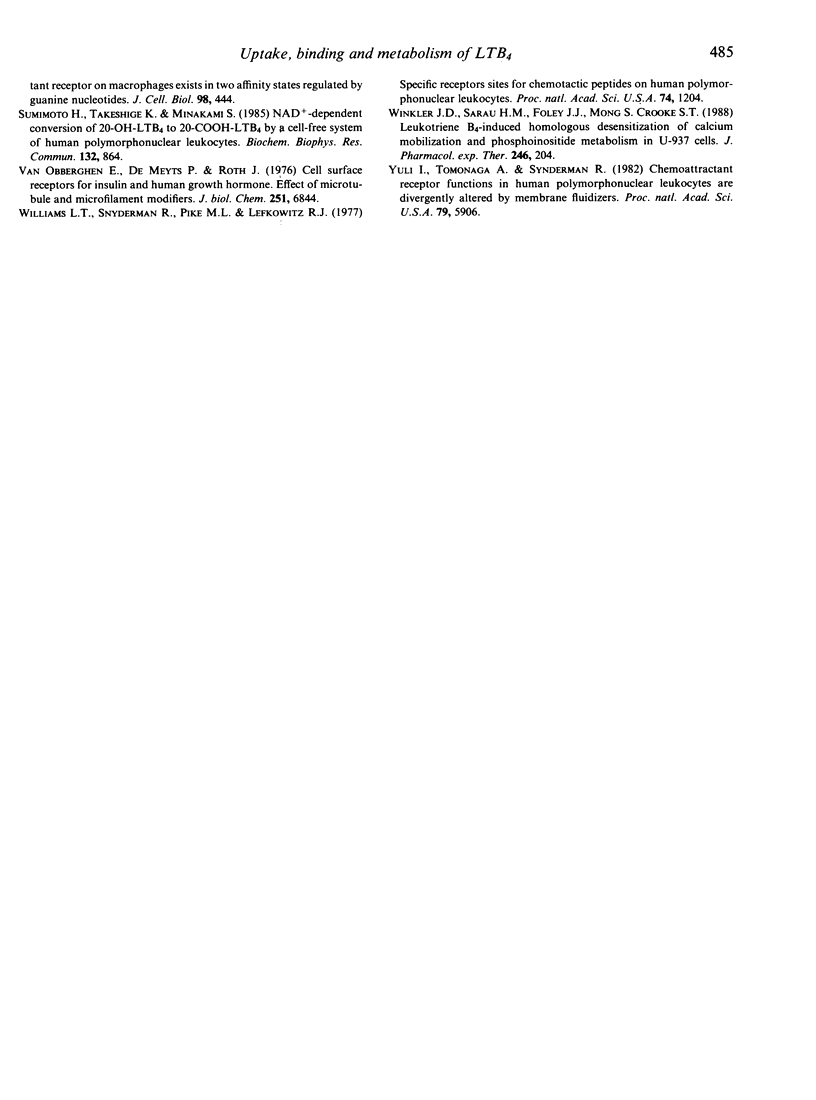
Selected References
These references are in PubMed. This may not be the complete list of references from this article.
- Al-Mohanna F. A., Hallett M. B. Actin polymerization modifies stimulus-oxidase coupling in rat neutrophils. Biochim Biophys Acta. 1987 Mar 11;927(3):366–371. doi: 10.1016/0167-4889(87)90101-7. [DOI] [PubMed] [Google Scholar]
- Aswanikumar S., Corcoran B., Schiffmann E., Day A. R., Freer R. J., Showell H. J., Becker E. L. Demonstration of a receptor on rabbit neutrophils for chemotactic peptides. Biochem Biophys Res Commun. 1977 Jan 24;74(2):810–817. doi: 10.1016/0006-291x(77)90375-8. [DOI] [PubMed] [Google Scholar]
- Borgeat P., Samuelsson B. Arachidonic acid metabolism in polymorphonuclear leukocytes: effects of ionophore A23187. Proc Natl Acad Sci U S A. 1979 May;76(5):2148–2152. doi: 10.1073/pnas.76.5.2148. [DOI] [PMC free article] [PubMed] [Google Scholar]
- Bray M. A. The pharmacology and pathophysiology of leukotriene B4. Br Med Bull. 1983 Jul;39(3):249–254. doi: 10.1093/oxfordjournals.bmb.a071828. [DOI] [PubMed] [Google Scholar]
- Brom J., Knöller J., Köller M., König W. Tumour necrosis factors modulate the affinity state of the leukotriene B4 receptor on human neutrophils. Immunology. 1988 Dec;65(4):647–649. [PMC free article] [PubMed] [Google Scholar]
- Brom J., König W., Stüning M., Raulf M., Köller M. Characterization of leukotriene B4-omega-hydroxylase activity within human polymorphonuclear granulocytes. Scand J Immunol. 1987 Mar;25(3):283–294. doi: 10.1111/j.1365-3083.1987.tb01074.x. [DOI] [PubMed] [Google Scholar]
- Brom J., Schönfeld W., König W. Metabolism of leukotriene B4 by activated human polymorphonuclear granulocytes. Immunology. 1988 Jul;64(3):509–518. [PMC free article] [PubMed] [Google Scholar]
- Böyum A. Isolation of mononuclear cells and granulocytes from human blood. Isolation of monuclear cells by one centrifugation, and of granulocytes by combining centrifugation and sedimentation at 1 g. Scand J Clin Lab Invest Suppl. 1968;97:77–89. [PubMed] [Google Scholar]
- Curnutte J. T., Babior B. M., Karnovsky M. L. Fluoride-mediated activation of the respiratory burst in human neutrophils. A reversible process. J Clin Invest. 1979 Apr;63(4):637–647. doi: 10.1172/JCI109346. [DOI] [PMC free article] [PubMed] [Google Scholar]
- Della Bianca V., Grzeskowiak M., Dusi S., Rossi F. Fluoride can activate the respiratory burst independently of Ca2+, stimulation of phosphoinositide turnover and protein kinase C translocation in primed human neutrophils. Biochem Biophys Res Commun. 1988 Feb 15;150(3):955–964. doi: 10.1016/0006-291x(88)90722-x. [DOI] [PubMed] [Google Scholar]
- Goldman D. W., Goetzl E. J. Heterogeneity of human polymorphonuclear leukocyte receptors for leukotriene B4. Identification of a subset of high affinity receptors that transduce the chemotactic response. J Exp Med. 1984 Apr 1;159(4):1027–1041. doi: 10.1084/jem.159.4.1027. [DOI] [PMC free article] [PubMed] [Google Scholar]
- Goldman D. W., Goetzl E. J. Specific binding of leukotriene B4 to receptors on human polymorphonuclear leukocytes. J Immunol. 1982 Oct;129(4):1600–1604. [PubMed] [Google Scholar]
- Hansson G., Lindgren J. A., Dahlén S. E., Hedqvist P., Samuelsson B. Identification and biological activity of novel omega-oxidized metabolites of leukotriene B4 from human leukocytes. FEBS Lett. 1981 Jul 20;130(1):107–112. doi: 10.1016/0014-5793(81)80676-x. [DOI] [PubMed] [Google Scholar]
- Heron D. S., Shinitzky M., Hershkowitz M., Samuel D. Lipid fluidity markedly modulates the binding of serotonin to mouse brain membranes. Proc Natl Acad Sci U S A. 1980 Dec;77(12):7463–7467. doi: 10.1073/pnas.77.12.7463. [DOI] [PMC free article] [PubMed] [Google Scholar]
- Jesaitis A. J., Bokoch G. M., Tolley J. O., Allen R. A. Lateral segregation of neutrophil chemotactic receptors into actin- and fodrin-rich plasma membrane microdomains depleted in guanyl nucleotide regulatory proteins. J Cell Biol. 1988 Sep;107(3):921–928. doi: 10.1083/jcb.107.3.921. [DOI] [PMC free article] [PubMed] [Google Scholar]
- Jesaitis A. J., Tolley J. O., Allen R. A. Receptor-cytoskeleton interactions and membrane traffic may regulate chemoattractant-induced superoxide production in human granulocytes. J Biol Chem. 1986 Oct 15;261(29):13662–13669. [PubMed] [Google Scholar]
- Knöller J., Schönfeld W., Köller M., Hensler T., König W. Arachidonic acid metabolites from polymorphonuclear leukocytes of healthy donors, severely burned patients and children with cystic fibrosis--routine monitoring by high-performance liquid chromatography. J Chromatogr. 1988 Jun 3;427(2):199–208. doi: 10.1016/0378-4347(88)80122-1. [DOI] [PubMed] [Google Scholar]
- Koo C., Lefkowitz R. J., Snyderman R. Guanine nucleotides modulate the binding affinity of the oligopeptide chemoattractant receptor on human polymorphonuclear leukocytes. J Clin Invest. 1983 Sep;72(3):748–753. doi: 10.1172/JCI111045. [DOI] [PMC free article] [PubMed] [Google Scholar]
- Koo C., Lefkowitz R. J., Snyderman R. The oligopeptide chemotactic factor receptor on human polymorphonuclear leukocyte membranes exists in two affinity states. Biochem Biophys Res Commun. 1982 May 31;106(2):442–449. doi: 10.1016/0006-291x(82)91130-5. [DOI] [PubMed] [Google Scholar]
- Kreisle R. A., Parker C. W. Specific binding of leukotriene B4 to a receptor on human polymorphonuclear leukocytes. J Exp Med. 1983 Feb 1;157(2):628–641. doi: 10.1084/jem.157.2.628. [DOI] [PMC free article] [PubMed] [Google Scholar]
- Lefer A. M. Leukotrienes as mediators of ischemia and shock. Biochem Pharmacol. 1986 Jan 15;35(2):123–127. doi: 10.1016/0006-2952(86)90502-2. [DOI] [PubMed] [Google Scholar]
- Liao C. S., Freer R. J. Cryptic receptors for chemotactic peptides in rabbit neutrophils. Biochem Biophys Res Commun. 1980 Mar 28;93(2):566–571. doi: 10.1016/0006-291x(80)91114-6. [DOI] [PubMed] [Google Scholar]
- Lohr K. M., Snyderman R. Amphotericin B alters the affinity and functional activity of the oligopeptide chemotactic factor receptor on human polymorphonuclear leukocytes. J Immunol. 1982 Oct;129(4):1594–1599. [PubMed] [Google Scholar]
- Mackin W. M., Huang C. K., Becker E. L. The formylpeptide chemotactic receptor on rabbit peritoneal neutrophils. I. Evidence for two binding sites with different affinities. J Immunol. 1982 Oct;129(4):1608–1611. [PubMed] [Google Scholar]
- Melikhova E. M., Kurochkin I. N., Zaitsev S. V., Varfolomeev S. D. Analysis of ligand-receptor binding by the difference method. Anal Biochem. 1988 Dec;175(2):507–515. doi: 10.1016/0003-2697(88)90575-1. [DOI] [PubMed] [Google Scholar]
- O'Flaherty J. T., Redman J. F., Jacobson D. P. Protein kinase C regulates leukotriene B4 receptors in human neutrophils. FEBS Lett. 1986 Oct 6;206(2):279–282. doi: 10.1016/0014-5793(86)80996-6. [DOI] [PubMed] [Google Scholar]
- Painter R. G., Zahler-Bentz K., Dukes R. E. Regulation of the affinity state of the N-formylated peptide receptor of neutrophils: role of guanine nucleotide-binding proteins and the cytoskeleton. J Cell Biol. 1987 Dec;105(6 Pt 2):2959–2971. doi: 10.1083/jcb.105.6.2959. [DOI] [PMC free article] [PubMed] [Google Scholar]
- Perez H. D., Elfman F., Lobo E. Removal of human polymorphonuclear leukocyte surface sialic acid inhibits reexpression (or recycling) of formyl peptide receptors. A possible explanation for its effect on formyl peptide-induced polymorphonuclear leukocyte chemotaxis. J Immunol. 1987 Sep 15;139(6):1978–1984. [PubMed] [Google Scholar]
- Rosenthal H. E. A graphic method for the determination and presentation of binding parameters in a complex system. Anal Biochem. 1967 Sep;20(3):525–532. doi: 10.1016/0003-2697(67)90297-7. [DOI] [PubMed] [Google Scholar]
- Shak S., Goldstein I. M. Leukotriene B4 omega-hydroxylase in human polymorphonuclear leukocytes. Partial purification and identification as a cytochrome P-450. J Clin Invest. 1985 Sep;76(3):1218–1228. doi: 10.1172/JCI112077. [DOI] [PMC free article] [PubMed] [Google Scholar]
- Sherman J. W., Goetzl E. J., Koo C. H. Selective modulation by guanine nucleotides of the high affinity subset of plasma membrane receptors for leukotriene B4 on human polymorphonuclear leukocytes. J Immunol. 1988 Jun 1;140(11):3900–3904. [PubMed] [Google Scholar]
- Snyderman R., Pike M. C., Edge S., Lane B. A chemoattractant receptor on macrophages exists in two affinity states regulated by guanine nucleotides. J Cell Biol. 1984 Feb;98(2):444–448. doi: 10.1083/jcb.98.2.444. [DOI] [PMC free article] [PubMed] [Google Scholar]
- Sumimoto H., Takeshige K., Minakami S. NAD+-dependent conversion of 20-OH-LTB4 to 20-COOH-LTB4 by a cell-free system of human polymorphonuclear leukocytes. Biochem Biophys Res Commun. 1985 Nov 15;132(3):864–870. doi: 10.1016/0006-291x(85)91887-x. [DOI] [PubMed] [Google Scholar]
- Van Obberghen E., De Meyts P., Roth J. Cell surface receptors for insulin and human growth hormone. Effect of microtubule and microfilament modifiers. J Biol Chem. 1976 Nov 10;251(21):6844–6851. [PubMed] [Google Scholar]
- Williams L. T., Snyderman R., Pike M. C., Lefkowitz R. J. Specific receptor sites for chemotactic peptides on human polymorphonuclear leukocytes. Proc Natl Acad Sci U S A. 1977 Mar;74(3):1204–1208. doi: 10.1073/pnas.74.3.1204. [DOI] [PMC free article] [PubMed] [Google Scholar]
- Winkler J. D., Sarau H. M., Foley J. J., Mong S., Crooke S. T. Leukotriene B4-induced homologous desensitization of calcium mobilization and phosphoinositide metabolism in U-937 cells. J Pharmacol Exp Ther. 1988 Jul;246(1):204–210. [PubMed] [Google Scholar]
- Yuli I., Tomonaga A., Synderman R. Chemoattractant receptor functions in human polymorphonuclear leukocytes are divergently altered by membrane fluidizers. Proc Natl Acad Sci U S A. 1982 Oct;79(19):5906–5910. doi: 10.1073/pnas.79.19.5906. [DOI] [PMC free article] [PubMed] [Google Scholar]


